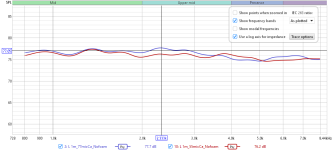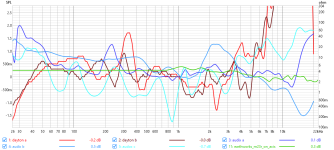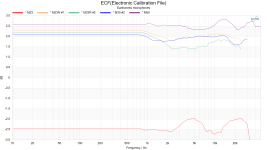Do you wish to tell us which curve is the 2022 one? The green one?calibration files of a ECM8000 calibrated by Cross Spectrum Labs in 2009 and again in 2022
I don't really, really know. But my test showed that the more expensive microphones stayed the same relative to each other, whereas the cheap Behringer did not.And how do you really, really know that ‘good’ microphone doesn’t drift?
Thanks! So it actually drifted to more linear 😀. My experience with an ECM8000 is pretty alike. In 10 years time not that much drift. But still. Earthworks recommends calibration each 5 years. With professional grade sound lab stuff annually is some kind of upper limit.the yellow one is 2022 and the green one is 2009
Now our requirements aren’t that high most of the time. Level deviations of some tenths to half of a dB are acceptable. The noise figures often are determined by diaphragm size. Leaving distortion figures and the drift in those as the big unknown. Has anyone ever inquired for a pro grade full calibration service that includes distortion figures? You can buy a nice new classy measurement microphone for that kind of money.
So let’s not fool ourselves. Unless properly calibrated, we have to administer for uncertainties in our acoustic measurements with older mikes. Which likely are in the order of magnitude applying to the difference between ‘cheap’ mike - ‘reasonable’ mike. Luckily at least some parties offer limited calibration services for budget prices.
You are probably asking a rhetorical question. But I'll bite.Has anyone ever inquired for a pro grade full calibration service
I recently (2024) enquired about a calibration here in Australia-
I was offered an Accredited Calibration
"Accredited calibrations are performed in service centers accredited by the local accreditation bodies according to EN ISO/IEC 17025 standards. This proves the traceability back to the International System of Units (SI).
A calibration includes the following measurements:
- Visual inspection
- Sensitivity measurements
- Frequency response
I'm not sure if there are (m)any other labs in Australia that can offer accredited calibration that's traceable back to SI units
The cost was AUD $1400, ex taxes. (2 significant figures). For those not familiar with AUD, at the time of the enquiry, the exchange rate for Australian micro pesos is US$ 950, €880 or £750.
Some organizations/companies may require this for policy/legal requirements, and thus turn this into a taxable business expense. But it was enough to stop me from enquiring about extended testing (like distortion measurements)
There's probably a small business opportunity for someone like @IamJF who can provide distortion measurements for microphones.
Unfortunately he's too busy in his day job, designing/building speakers and microphones pre-amps for the microphones companies...
If there's a single one line summary I could give is, if you want a microphone that has lower self-distortion eg. <0.01% THD (< -80dB, H2 bound), look for one that can handle HIGHER SPL at given %THD. eg. 160dB @3% THD; 145dB @1 THD.
It may be a little while before low cost microphones with low distortion arrive...(see below article)
Attachments
Last edited:
I used to offer exactly that as a service. It's not exactly a big business, and more work than you want it to be. I stopped offering it as it's not worth my time.A calibration includes the following measurements:
The calibration certificate specifies the measurement uncertainty.
- Visual inspection
- Sensitivity measurements
- Frequency response
Thanks once again! Also for the article. So we finally will get rid of that f2 which so much of us love to hear (pun intended)?You are probably asking a rhetorical question. But I'll bite.
If inspecting a mic for damage, providing electronic conpensation file, and sensitivity figures on a certificate that is traceable back to SI standards costs only €880
How much would additional distortion analysis cost?
? €1000
Why bother, as you say.
Time to buy a new mic
How much would additional distortion analysis cost?
? €1000
Why bother, as you say.
Time to buy a new mic
Last edited:
We used a LOT of B&K 4133 microphones when we made speakers in the UK. They were calibrated annually. Actually B&K, Manchester, calibrated one mike for us each year and we used that to calibrate the others. But each mike's calibration could be traced back to the B&K UK NPL standard
In some 2 decades, NONE of them were more than 0.2dB out except when there was obvious damage.
For electrets (eg the Behringer, ECM8000), I have some experience this Century. It depends on the environment where they are used & stored.
Over, a 10 yr period, a mike stored in an air-conditioned studio, in Oxford, UK has no detectable (<0.2dB) change. In the same period, a mike (mine) in Cooktown, Oz had unacceptable changes in both sensitivity and response (1dB). These are the limits of quite a few which have passed through my hands this Millenium. Most were not quite as bad as the Cooktown sample or as good as the Oxford one.
A 'modern' electret 'measurement' mike for DIY work or recording which doesn't need traceable calibration for legal reasons, is probably OK if re-calibrated every 2 yrs. I include the Earthworks in this call.
In some 2 decades, NONE of them were more than 0.2dB out except when there was obvious damage.
For electrets (eg the Behringer, ECM8000), I have some experience this Century. It depends on the environment where they are used & stored.
Over, a 10 yr period, a mike stored in an air-conditioned studio, in Oxford, UK has no detectable (<0.2dB) change. In the same period, a mike (mine) in Cooktown, Oz had unacceptable changes in both sensitivity and response (1dB). These are the limits of quite a few which have passed through my hands this Millenium. Most were not quite as bad as the Cooktown sample or as good as the Oxford one.
A 'modern' electret 'measurement' mike for DIY work or recording which doesn't need traceable calibration for legal reasons, is probably OK if re-calibrated every 2 yrs. I include the Earthworks in this call.
Consistent with B&K material:

"Artificial Ageing During production, the microphone cartridges are subjected to a high temperature (150°C), forced ageing process which ensures excellent long-term stability. The predicted long-term stability is of the order of 1 dB over several hundred years at room temperature. Although difficult to verify this in practice, the sensitivities of several microphone cartridges measured periodically at Brüel & Kjær’s laboratory from 1974 to 1990 changed by only 0.05 dB, confirming the predicted long term stability"
"Artificial Ageing During production, the microphone cartridges are subjected to a high temperature (150°C), forced ageing process which ensures excellent long-term stability. The predicted long-term stability is of the order of 1 dB over several hundred years at room temperature. Although difficult to verify this in practice, the sensitivities of several microphone cartridges measured periodically at Brüel & Kjær’s laboratory from 1974 to 1990 changed by only 0.05 dB, confirming the predicted long term stability"
I see a long term drift test of cheap and middle priced microphones coming up…
But from a practical pov you can buy the one you like best and either send it for a check every few years or buy a cheap corrected one and compare yourself every couple of years. The latter option then again fills your closet unless you resell them. All viable and giving us instruments within the tolerances we need.
But from a practical pov you can buy the one you like best and either send it for a check every few years or buy a cheap corrected one and compare yourself every couple of years. The latter option then again fills your closet unless you resell them. All viable and giving us instruments within the tolerances we need.
I just purchased the cheap Dayton iMM-6 mic, downloaded the calibration file and the Room EQ Wizard soft and measured my Dynaudio Emit speakers at their normal computer tabletop location from my normal sitting position.
The yellow line looks sufficiently crappy, the green line I don't even know what it is. Do you think the measurement is correct enough? How would you interpret it?
You don't know what it is, and we are supposed to tell you if it's correct? I'd suggest to RTFM....I don't even know what it is. Do you think the measurement is correct enough? How would you interpret it?
My two dayton mics show a difference when measuring the same thing:

I did not expect them to match but I wish they did.
So I thought I'd compare the calibration files of a few mics. Huge props to Audix support for sending me some random cal files. Comparing the audix cal (blue shades), my 2 dayton mics(red shades), and an a m23r earthworks I found online (green)

The cal for the earthworks looks less extreme. The dayton look the worst. The audix in the middle.
This post on another site went through a few earthworks mics:
https://www.audiosciencereview.com/...-deviation-of-6-earthworks-microphones.40546/

I am waiting to see if earthworks will send me some calibration files before making a choice.

I did not expect them to match but I wish they did.
So I thought I'd compare the calibration files of a few mics. Huge props to Audix support for sending me some random cal files. Comparing the audix cal (blue shades), my 2 dayton mics(red shades), and an a m23r earthworks I found online (green)

The cal for the earthworks looks less extreme. The dayton look the worst. The audix in the middle.
This post on another site went through a few earthworks mics:
https://www.audiosciencereview.com/...-deviation-of-6-earthworks-microphones.40546/

I am waiting to see if earthworks will send me some calibration files before making a choice.
What exactly is your approach and purpose wirh this comparison? All I can tell is that every microphone is different.
Maybe I can dig out some old curves from when I still did tbe cal work.
Maybe I can dig out some old curves from when I still did tbe cal work.
I just wanted to see what could be seen.What exactly is your approach and purpose wirh this comparison?
I think I would rather own a mic that leans flat and uses a mild calibration vs one that looks like the rocky mountains.
We’re talking about deviations of +/- 1 to 1,5dB for most of them. These are mild corrections. There’s hardly any need for more linearity. Better get your trusty low budget mike checked periodically than owning an expensive one of which you assume it’s straight.I think I would rather own a mic that leans flat and uses a mild calibration
- Home
- Loudspeakers
- Multi-Way
- Measurement mics